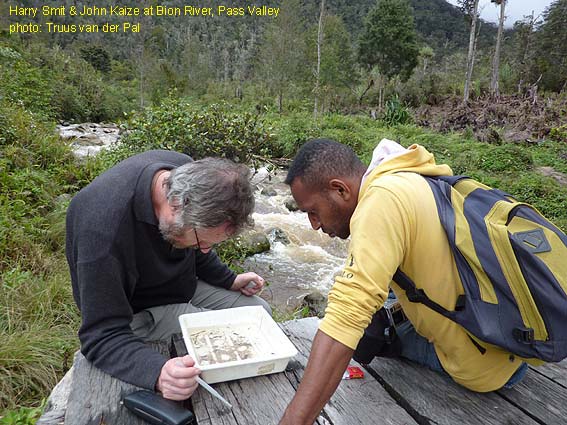
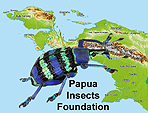


October 2010
(updated on 21 December 2010)
other issues of our Newsletter:
August 2008 - March 2009 - November 2009 - December 2011
Papua-Insects.nl
The Papua Insects Foundation
The latest news on the Papua Insects Foundation, its website and other relevant items concerning the entomology study in New Guinea
With this newsletter we want to inform you about the latest developments, news and changes in the website and activities of the Papua Insects Foundation and other interesting entomological news of New Guinea. If you have any questions or comments on this, please contact us.
1st Papua entomology meeting on 17th December 2010 was a success despite a snow blizzard
On Friday 17th December 2010 the Papua Insects Foundation organized an afternoon of lectures in NCB-Naturalis, Leiden, The Netherlands, on Papua entomology. About 30 notified contributors and interested people applied to this meeting but because of severe snowfall the public traffic was disrupted and a total of 19 people attended the meeting, which is regarding the terrible weather conditions quite satisfactory.
Present at the meeting were: Arnold de Boer [Hemiptera: cicadas], Chris Davenport (United Kingdom) [Lepidoptera], Hans Duffels [Hemiptera: cicadas], Jari Hyvärinen (Finland) [Lepidoptera], Vincent Kalkman [Odonata], Henk van Mastrigt [Lepidoptera], Wolfram Mey (Germany) [Trichoptera & Lepidoptera], Erik van Nieukerken [Lepidoptera], Marieke Schouten [Hemiptera: cicadas], Jannie and Siep Sinnema [Lepidoptera], Harry Smit [Acari], Daawia Suhartawan (Indonesia) [Lepidoptera], Josef Tumbrick (Germany) [Orthoptera], Ed de Vogel [Orchids], Rob de Vos [Lepidoptera], Evie Warikar (Indonesia) [Coleoptera], Gerrit Withaar [Coleoptera], Jaap Zwier [Lepidoptera].
Unfortunately, Piet Zumkehr, our chairman, was stuck in traffic because of the snow. Therefore the opening was done by organizer Vincent Kalkman and Rob de Vos (secretary) briefly went through the text of the first speaker on the results and future aims of the Papua Insects Foundation, followed by his own lecture with details on the website (papua-insects.nl), its results and future aims and wishes.
Daawia Suhartawan, biology teacher at the University of Cenderawasih (Waena, Papua, Indonesia) and at the moment studying in Göttingen, Germany, held an interesting lecture on the biology and ecology of Ornithoptera paradisea arfakensis in the Arfak Mountains. She showed some nice pictures of her fieldwork study on this butterfly and discussed some of the results of her research.
Harry Smit is specialized in watermites (Acari) and showed some results and pictures of his fieldtrip to Papua, Indonesia, held in February 2010. The most striking conclusion was that Lake Sentani and Lake Habbema did not give any results. Lake Sentani probably by a disturbed ecology system caused by too many sweet water Crustacea, while Lake Habbema probably forms a violent environment for Acari because of the accid influence of Sphagnum. On the other hand new species have been found in other water systems and probably many more are to be expected since little is yet known of the Acari fauna of Papua.
Evie Warikar, also a biology teacher at the University of Cenderawasih (Waena, Papua, Indonesia) and studying in Göttingen, Germany, held a lecture on beetles related to logging of forest. For her fieldwork in Bonggo in the Northeast of Papua (near Sarmi) she used quite simple but effective beetle traps made of cardboard with a tube of 70% alcohol (to attract the beetles) and a trap container with salted water to catch the insects. The effectiveness of such a simple trap is shown by the results of more than 3000 specimens in only one month! Many beetles still have to be identified, even at family level, and she is desperately waiting for specialists willing to do this. Some of the families which she collected were Curculionidae, Brentidae, Anthribidae, Cerambycidae, Elateridae, Staphylinidae, Scolytidae (and other unidentified Bark beetles families), Carabidae, Tenebrionidae, Buprestidae, Histeridae, Mordellidae and others.
Marieke Schouten is specialized in Singing Cicadas (Hemiptera, Auchenorrhyncha) and together with Arnold de Boer, another specialist on this group of insects, she was searching for specimens of the tribe Cicadettini for a DNA barcode project of Chris Simon in Connecticut, USA. Although they catched many cicadas, there was only one locality where the genus Nigripsalta did appear. She discussed the cicada diversity along an elevation gradient in Papua. It was noticed that the higher the altitude the less species occurred.
Vincent Kalkman gave a brief report on the expedition of Conservation International to the Muller Range, PNG. A survey of dragonflies was conducted at three sites in the Muller Range of south-central Papua New Guinea (PNG) in 2009. Thirty-six species were documented, of which 31 were found only at the lowland site. Diversity at Camp 1 (Gugusu; ~500 m asl) was similar to that documented from the limited number of other sites studied in the central mountain range. Diversity was extremely low at Camp 2 (1600 m asl; 1 species) and Camp 3 (2875 m asl; 4 species). The karst area at camp 2 is largely devoid of aquatic habitats and hence has a very poor dragonfly fauna. Camp 3 was above the altitudinal limit of all but a few species. However the discovery of the presumed larvae of Papuagrion at Camp 3 constitutes the first record of larvae of this genus. Its life-style (aboreal and semi-terrestrial) is unique among dragonflies and warrants more research.
Ed de Vogel is not an entomologist but is specialized in orchids. For the series "The Orchids of New Guinea" he traveled through PNG and Papua many times. He shows interesting pictures of most beautiful species and maps were they occur. He also gives us a tour through the six parts of the DVD series he made for ETI.
Finally, Henk van Mastrigt shows some maps of the early and recent expeditions held in Papua. He shows the increase of places where explorers have been and the still existing "white areas" which should be visited in the near future. He also discussed the (im)possibilities of recent surveys in Papua, Indonesia.
At the end of the meeting most of the participants joined for a diner at a restaurant in Leiden. After dinner all struggled and suffered to find their way home through the snow but despite the weather elements we can look back at a successful first Papua meeting.
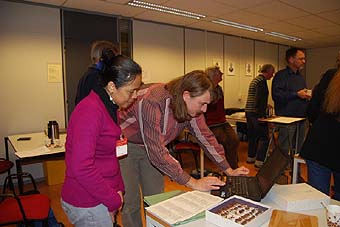
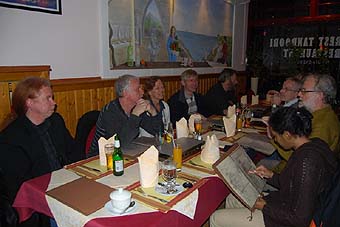
Volume 4(4) (April - June 2010) and 5(1) (July - September 2010) of SUGAPA is released
SUGAPA is a continuation of the newsletter "SUGAPA" of the Kelompok Entomologi Papua (KEP) which started in July 2006 and since then published 8 issues on the activities of the members of KEP, a group of enthousiast Papuan biology students and teachers of the Cenderawasih University (UNCEN), with Henk van Mastrigt as guide and teacher. Initially the language in the newsletter was Bahasa Indonesia, which was a problem for most interested scientist. The Papua Insects Foundation therefore presented English translated abstracts on the website.
SUGAPA is sponsored by the Van Tienhoven Foundation in The Netherlands. For more information about this foundation click on the logo at the right.
The magazine SUGAPA focusses on international scientists and deal with subjects on Papuan insects. The text will be mostly in English (about 25 % will be in Bahasa Indonesia). More information or subscription
The editors of SUGAPA appeal for entomologists to contribute in their journal, so if you have manuscripts (almost) ready on Papuan insects and want to publish in SUGAPA, please contact the editorial board of SUGAPA.
We like to emphasize that SUGAPA is a registered journal (ISSN 1978-9807) and independently founded by KEP, but it is obvious that the Papua Insects Foundation fully supports this initiative with what we can.
The grow of subscriptions to SUGAPA is less than we expected but we hope that with good advertisement and "mouth to mouth" recommendation the subscriptions will grow to the necessary minimum to cover the finances of the magazine. The most important aim of this magazine is not just making it possible to publish in it quite easy, but to develope a magazine in which most entomologists will publish their information on Papuan insects and to be available to teachers and students in Papua and further.
Issue 4(4) contains (see also the abstracts):
Francesco Vitali & Herlina Menufandu - A new species of Protilema Aurivillius, 1908 (Coleoptera: Cerambycidae, Morimopsini) from Waigeu Island, New Guinea
Francesco Vitali - Taxonomic and synonymic notes about some Indonesian species of the genus Acalolepta Pascoe, 1858 (Coleoptera: Cerambycidae, Lamiini)
Henk van Mastrigt, Iess Piran & Beatrix Wanma - Diversity and distribution of Papilionoidea (Lepidoptera) in the south eastern part of Papua, Indonesia
Stefan Schröder - A new species of Epimastidia Druce, 1891 from Papua, Indonesia (Lepidoptera: Lycaenidae)
Flora Gratiana Adeodata - Keanekaragaman dan Penyebaran Spesies Kupu-kupu Famili Nymphalidae (Subfamili Charaxinae, Apaturinae, Nymphalinae dan Heliconiinae) di Papua
Issue 5(1) contains:
Henk van Mastrigt - Cyrestis acilia (Godart, 1819) in Papua, Indonesia: its distribution, subspecies and forms (Lepidoptera: Apaturinae, Nymphalidae)
Santhi Kanony - The diversity and distribution of Nymphalid butterflies at the river site, gardens and forest, at Malawor village, District Makbon, Kabupaten Sorong, Papua Barat Province (in Bahasa Indonesia)
Tirza Natalia Agaki - The diversity of dragonflies and damselflies (Odonata) at the inlet and outlet of the Sentani Lake (in Bahasa Indonesia)
Alfred Kharum Wayeni - Study on the diversity of butterflies of the Superfamily Papilionoidea in District Supiori Barat, Kabupaten Supiori (in Bahasa Indonesia)
Yarius Pakage - The exploiration of the diversity of stick insects Order Phasmida in the Natural Reserve of the Cyclops Mountains, Kabupaten Jayapura (in Bahasa Indonesia)
New book announcement by The Entomological Society of Latvia:
"Biodiversity, Biogeography and Nature Conservation in Wallacea and New Guinea"
Apply for new papers: click for more information
NEW! A field guide to the butterflies of the Birdshead Peninsula
"Kupu-kupu, untuk Wilayah Kepala Burung Termasuk Pulau-pulau Provinsi Papua Barat" - by the team of Kelompok Entomologi Papua (KEP, "Workgroup Papua Insects")For more information click here
This field guide is sponsored by The World Wildlife Fund and the Dutch "Nationale Postcode Loterij"
Reports of some latest entomological visits to New Guinea
Euploea and other butterflies on Biak Island - Jari Hyvärinen
At the end of 2007 Jari Hyvärinen and Otso Reunanen from Finland visited the Island of Biak and discovered some very interesting Lepidoptera among which a new lithosiine moth, Damias biakensis De Vos & Hyvärinen, 2009 (Arctiidae). Its description can be found in SUGAPA 4(2), the last issue of 2009. Here is a report of their experiences on the main reason of their trip, observing butterflies:
Me and my colleague Otso Reunanen stayed at Biak from 4 - 14 December 2007 during our five weeks Indonesian trip (we also went to Sulawesi on our way to Biak). The people of Biak were very friendly and relaxed. We found some good guides, even though they do not speak English very well. I understand a little bit of Bahasa Indonesia and that helped at some occasions. With a better communication and mutual understanding it supported us to find some undisturbed places to observe butterflies.
Most of the areas near Kota Biak are cultivated or forest is logged. We were lucky to find a nice piece of jungle where the narrow road went across some quite old forest. It was about 40 minutes driving from Kota Biak. Other good collecting sites were the Japanese caves in the early morning before the tourists arrive. From dawn to noon there were a lot of butterflies but after noon, when temperatures got too high, the number was decreasing very fast.
We could only do observations for seven days in two places because for a couple of days there was a heavy rain the whole day long. We observed a total of 64 butterfly species, 2 Hesperiidae, 9 Papilionidae, 8 Pieridae, 10 Lycaenidae and 35 Nymphalidae. The dominant species were from the Papilioninae, Pierinae and Danainae, among which Euploea. Common butterflies were Papilio ambrax, Papilio aegeus, Cepora perimale, Eurema puella, Euploea morosa and Euploea leucostictos.
I paid attention to strong Müllerian mimicry of Euploea butterflies and the abundancy of species. In Biak there are even two endemic species of Euploea, E. tripunctata and E. albicosta. For observing Danainae Biak is a special place to be. We discovered that all of the other danaine butterflies were not common except for Euploea species. Usually in Indonesia and especially West from New Guinea we find the opposite. We did only see one specimen of Danaus affinis and Ideopsis juventa. Both are very common in Ambon and are the common danaine butterflies that can be found everywhere in large numbers. From other Nymphalinae we observed low numbers except for Cyrestis acilia, Phalanta alcippe and Pantoporia consimilis.
Drs. Rob de Vos (Zoological Museum of Amsterdam) discovered a new species of Arctiidae in my collected material, Damias biakensis. It is clear that Biak still hides natural history treasures.
A survey to the Onin and Bomberai Peninsula - Dmitry Telnov
From 3 - 30 September 2010 a survey was held on the Onin Peninsula near Fakfak by the Entomological Society of Latvia (Lettland) with Dimitry Telnov (Coleoptera), Martinš Kalninš (Odonata, aquatic Insecta) and Kristina Greke (non-marine Mollusca).
The original goal of this expedition was to visit the Van Rees (Gautier) mountains in the area around Danau Bira (also known as Lake Holmes). Because of difficulties in arranging research permit for this area and insufficient funding, our plans have changed significantly and the expedition visited the southern Birdhead Peninsula (Vogelkop) and the Fakfak mountains. Areas in surrounding of Kaimana, in Teluk Bistyari and Triton, as also along Lengguru River and so called Triton Lakes have never been explored entomologically during recent times (Fig. 1). Highly interesting are numerous rock paintings we have fully documented in some parts of Triton & Bistyari pays. This territory is familiar with their geology and is formed by several parallel and up to 1600 m high limestone anticlines and deep valleys between them. The whole area is very pristine with tree kangaroos (Dendrolagus spp.) and Palm Cockatoos (Probosciger aterrimus) still being common. Malaria is very common in the areas along Lengguru River and was approved by two of the three team members. ‘Conservation International’ office in Kaimana is dealing with marine protected area in Triton bay, but paused their activities because of a conflict with local villagers.
The Fakfak mountains are previously visited by entomologists many times, but still hiding many of their treasures from scientists. In this area we visited various habitats from coastal lowlands to mossy forests from 800 m and higher. Several ancient rock painting places and burial grounds with skulls and bones were visited and documented between Kokas and Goras. Several ecotourism spots situated along the road from Fakfak to Kokas are now all unattended and broken. Suffered birds of paradise (Paradisaea minor) are available for sale in WWF demo-village in the mountains! The central ridges of the Fakfak mountains is still very pristine and of very high biological value, but numerous small spots of illegal deforestation are found everywhere along the available roads, although a large poster in Fakfak city declares that the mountain area behind is a nature reserve.
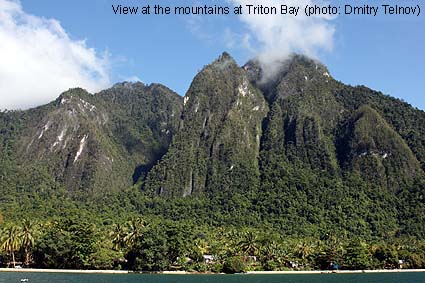
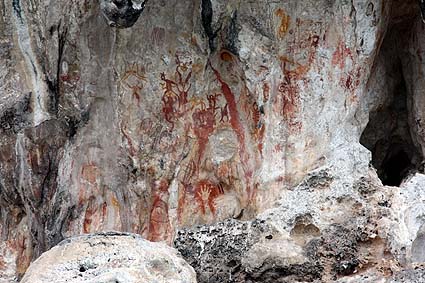
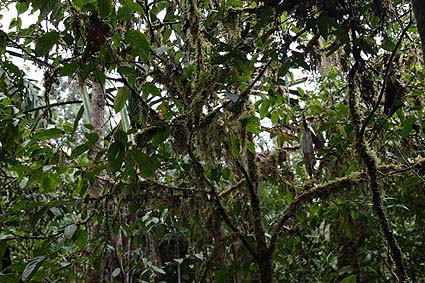
A water mite collecting trip to Papua, Indonesia - Harry Smit
Harry Smit is a scientific cooperator at the Zoological Museum of Amsterdam, specialized in water mites. In March 2010 he made a collecting survey in Papua, Indonesia. Places he visited are, among others, the Baliem Valley, Lake Habbema and Walmak (Jayawijaya Mountains).
Water mites (Acari: Hydrachnidia) are an important part of the aquatic ecosystem with a complex life cycle. Adults and deutonymphs are predators of small water animals, like water fleas (Cladocera), seed shrimps (Ostracoda) and chironomid larvae (Insecta, Chironomidae). The larvae are parasitic on many insects groups, like water bugs, water beetles, chironomids and damselflies.
Little is known about the water mites of New Guinea. The first paper was published in 1901 by Daday from ponds in German New Guinea, now Papua New Guinea. The Japanese acarologist Imamura (1983) described two more species from Papua New Guinea. Wiles (1997) published the most comprehensive study thus far. He visited in 1992 both Papua New Guinea and Papua Province of the Indonesian part. From the latter area he collected around Jayapura, Wamena and Lake Habbema. Wiles reported 76 species from New Guinea, while he left the specimens of three genera unidentified. This is a relatively low number compared to other islands nearby. From Australia more than 500 species are known. The total number worldwide is well over 6000!
In March 2010 I visited Papua, accompanied by my wife Truus van der Pal and John Kaize (see header picture of this newsletter), a Papuan biologist working on odonates. The first area we visited was Lake Sentani. To our disappointment we could not find any water mite. The invertebrate fauna was very impoverished, with a mass development of shrimps. Wiles (1997) reported one species from Lake Sentani, i.e. Koenikea timmsi, a species described from Australia. Wiles mentioned that the species was very common. Apparently the ecological situation deteriorated, leading to the mass development of shrimps and a very low biodiversity. Next day we went to the Cenderawasih University, where I was asked to give a lecture on water mites.
Next day we flew to Wamena, centre of the Baliem Valley. John succeeded in getting us on a taxi to Pass Valley. When we arrived next day at 6.30 AM in Pass Valley, the caretaker of the guest house was still asleep. We had somebody wake her up, and she was surprised to see us, because she expected us next week. But we had to change our plans because we couldn’t get a flight to Walmak. After we had installed ourselves at the nice guesthouse, we went to the close by Bion River. The water of this fast flowing river is tea-coloured brown. We managed to collect water mites, although the density was low. The following days we collected in small streams crossing the road to Pass Valley, as well as some tributaries of the Bion River. Everywhere the density of water mites was very low, and collecting was therefore slow. In 1-1.5 hour I collected usually less than ten water mites. Only in the Bion River itself numbers were a little bit higher, between 20 and 30 specimens. Every afternoon we had to stop collecting because of heavy rains.
Next Wednesday we had our shortest flight ever. It took only 8 minutes to Wamena. I asked the pilot if there were any flights to Walmak, and he said he was going there next morning. The flight to Walmak took half an hour, and gave us impressive views of the mountains of New Guinea. We installed us in the comfortable guesthouse, next to the airport (a grassy track). We visited a number of streams close to the village, but also here the density of mites was low. In streams downstream of the village, water mites were absent. The water quality was bad due to sewage from the village. Like in Pass Valley, in the afternoon we had heavy downpours. One day the heavy rain started already in the morning. John and I tried to visit the large river we could see in the distance below, but we didn’t succeed in reaching it. It is flowing very fast, and has no real access, at least not nearby. Walking here is sweaty, as the tracks are very muddy and steep. Some locations we were not allowed to visit, like the waterfall above the village. We visited a nearby village, and there I found a small pond, where I was able to collect water mites. Only one species present, very likely the genus Limnochares (when sorting the material at home it turned out to be indeed this genus). A second pond at another village yielded specimens of the same genus). Tuesday March 23 we were expected to have our flight back to Wamena. In the early morning the weather was fine, but slowly clouds came in and a drizzle started. We heard that our flight was delayed, so we were afraid that the plane couldn’t come at all. But luckily after a (long) while we heard the buzzing of the plane. Life animals were unloaded (pigs, chicken, dog) and we left for Wamena.
We wanted to go to Lake Habbema, a lake at 3300 m above sea level. This is an expensive trip. The first person we got in contact with asked 4 million Rp. John contacted the taxi driver who brought us to Pass Valley, and he wanted to do the trip for 3.5 million Rp. During the day we collected water mites in the Uwe River, a large river in the Baliem Valley. We were also able to collect some mites in a pool along the road to the Baliem Resort, some 10 km from Wamena.
Next day we left early for Lake Habbema. We passed a military checkpoint without problems. The road was pretty bad, due to heavy logging trucks. But we had a good driver and a good 4x4 car, so after some 2.5 hours we reached the lake. We had picked up a group of Papua’s, men, women and children. Near the lake the temperature was 8 ºC, so the men in traditional outfit were pretty cold. The scenery was beautiful here, low shrubby and grassy vegetation with in the distance the highest mountains of New Guinea. The road to the lake had been washed away, so we had to walk. All streams and pools were full of Sphagnum, which means that they are very acid. I only collected one small mite, which turned out to be an Oxus nymph (nymphs are hardly if at all identifiable). Wiles had collected a new Oxus species in Lake Habbema, but I was unable to collect mites. But I was very satisfied with the sighting of a Salvadori’s teal, a high altitude duck. On the way back the road was blocked by a logging truck with problems, but we were able to pass it on the shoulders of the small road.Next day we took a flight to Sentani. The next days we visited a number of lowland streams, including the outlet of Lake Sentani. In this deep and fast flowing stream I was able to collect only one water mite. Local people collect freshwater clams, but these were without mites. Species of the genus Unionicola live in these clams. In a forest pool along the road to this outlet, however, water mites were abundant. Next days we visited a number of streams with local transport. Especially the River Yabawi, upstream of Harapan, was good for collecting mites. Also we were able to collect water mites in the sea at Base G. Two genera occur in the marine littoral, worldwide in tropical and subtropical regions. The pools in the Pandanus forest bordering the sea had water mites also (and many mosquitoes).
We sampled in the streams near UNCEN, the university compounds. Collecting here was good, also in the small forest streams behind the university.Final conclusions: Density of water mites was low, and diversity was also less than expected. Most numerous were members of the genus Monatractides, a genus occurring worldwide. The sister taxon of the genus, Torrenticola, is however absent in the Indo-Australian region. Together with Vladimir Pešic (University of Montenegro), the Monatractides material is in elaboration. Very likely four species new to science have been collected.
References
Daday, E. von, 1901. Mikroskopische Süßwasserthiere aus Deutsch-Neu-Guinea. Természetr. Füzetek. 24(1-2): 1-56.
Imamura, T., 1983. A new subfamily and two new species of water mite (Acari: Hydrachnellae) from Papua New Guinea. Proc. Jap. Soc. Syst. Zool. 26: 11-18.
Wiles, P.R., 1997. The water mites (Acari: Hydrachnidia) of New Guinea. The Raffles Bulletin of Zoology 45 (2): 375-418.
News on the website - Rob de Vos
New thumbnail galleries have been added to the website and more are yet to come. From the statistics of the website visits it shows that we had an increasing number of visitors with a daily average of more than 7800. Many "hits" are from search strings by pictures which makes it very important to have the pictures file named with a logical and recognizable (species) name.
Renovations and corrections in the website are part of a daily practice to keep the website up to date and are ongoing. Here follows a list of the major novities on the website since last newsletter. Minor changes are numerous and you will understand that we cannot list those.
We like to attend you to the link on the homepage of the latest released SUGAPA magazine. At this moment issue 4(4) is the latest one and abstracts are on line.
Of the insects pages, in fact the most important part of the website, the following list shows the new or renewed checklists
- Neuroptera: Ascalaphidae, Chrysopidae, Coniopterygidae, Hemerobiidae, Mantispidae, Myrmeleontidae, Nymphidae, Osmylidae (Willem Hogenes) Checklists of the species per family [April 2010]
- Diptera: Syrphidae (Joaquin (Ximo) Mengual & F. Christian Thompson) A checklist of the species [February 2010]
- Lepidoptera: Hepialidae (Rob de Vos) A checklist and species pages with genitalia overview [April 2010]
- Lepidoptera: Cossidae (Rob de Vos) A checklist and species pages [August 2010]
- Lepidoptera: Micronoctuidae (Michael Fibiger) A checklist (yet just one species!) [September 2010]
- Coleoptera: Curculionoidea (Alexander Riedel) All family checklists completed [October 2010]
In the Lepidoptera listing of the Noctuidae, together with species pages, is at the moment being prepared. You will understand that this large Lepidoptera family will take time to complete. The Arctiidae pages will be renewed, low quality pictures will be replaced and new and updated distribution maps will be presented. In the Coleoptera a checklist of the Dytiscidae (Michael Balke) and Staphylinidae (Arnaldo Bordoni) will soon be on line.
We hope that contributors who promissed us a checklist of their insect group will soon send it to us for preparing.
Have a look at the following interesting new History pages:
- Information on the Central New Guinea Expedition (1920-1921)
- A map of the route of the Adolf Bernhard Meyer Expedition (1873). Soon informative text will be added too.
- An interesting part of the biography of Louis-Antoine de Bougainville (1729-1811)
Available thumbnails at this moment are:
- Odonata: Anisoptera
- Odonata: Zygoptera
- Hemiptera: Auchenorrhyncha (Cicadidae, Tibicinidae)
- Hemiptera: Auchenorrhyncha (Fulgoridae, Flatidae)
- Hemiptera: Heteroptera (Pyrrhocoridae, Miridae, Tessaratomidae)
- Hemiptera: Heteroptera (all families, unidentified specimens)
- Coleoptera: Anthicidae
- Coleoptera: Carabidae
- Coleoptera: Cerambycidae (Lamiinae)
- Coleoptera: Cerambycidae (Prioninae)
- Coleoptera: Cerambycidae (Cerambycinae)
- Coleoptera: Cicindelidae
- Coleoptera: Curculionoidea, Brentidae
- Coleoptera: Curculionoidea, Curculionidae
- Coleoptera: Endomychidae
- Coleoptera: Scarabaeidae (Cetoniinae)
- Lepidoptera: Hepialidae
- Lepidoptera: Cossidae
- Lepidoptera: Alucitidae
- Lepidoptera: Pterophoridae
- Lepidoptera: Tortricidae
- Lepidoptera: Sphingidae
- Lepidoptera: Thyatiridae
- Lepidoptera: Noctuidae (Aganainae)
- Lepidoptera: Noctuidae (Agaristinae)
- Lepidoptera: Noctuidae (Cocytiinae & Eucocytiinae)
- Lepidoptera: Noctuidae (Plusiinae)
Appeal for more information on other insect groups and items for the next newsletter
At the moment we have contact with more than 50 entomologists in the world who more or less contribute to our website or promissed to do so. We would appreciate your cooperation to provide us of information and checklists of your specialism concerning New Guinea in general or Papua Indonesia in particular. If you know of some other specialists who potentially could be interested to contribute to our website, please let him/her know of us or inform us.
If you have interesting news or information to put in the next newsletter you are very welcome to. Please contact the webmaster to deliver and discuss your contribution.
We rely on you!